Page 3 of 7
Re: Pigeons and Doves - Bird of the Month February 2014
Posted: Sun Feb 09, 2014 7:13 pm
by nan
Re: Pigeons and Doves - Bird of the Month February 2014
Posted: Sun Feb 09, 2014 7:31 pm
by Flutterby
The male Namaqua dove (Oena capensis) is a striking bird, with a black face and throat accompanied by a vibrant red and yellow bill. The female Namaqua dove lacks the bright bill and the black ‘mask’ of the male, but both sexes have an impressively long, mostly black tail. The rest of the Namaqua dove’s plumage consists of blue-grey on the head progressing subtly into pale brown on the back. Juvenile Namaqua doves are a fawn colour with many black speckles.
While not a very vocal bird, the Namaqua dove does make quiet cooing sounds as well as a series of short notes descending in pitch.
The Namaqua dove is the only species in the genus Oena, but it is very similar to doves in the genus Turtur, which have similar colour patterns on the wings and bill, and similar speckled plumage on the juvenile. However, the Namaqua dove can be distinguished from these similar species by its long tail and the marked differences in plumage between the sexes.
Biology
The Namaqua dove’s diet consists primarily of small grass seeds, though it will occasionally also eat invertebrates. It occurs mainly singly or in pairs, although large flocks of several hundred Namaqua doves may form around water or abundant food sources. While some Namaqua dove populations remain in the same area all year round, some are nomadic, moving from place to place, and others migrate seasonally. These seasonal migrations seem to be related to rainfall.
Nest construction by the Namaqua dove usually begins in March in Arabia, although in parts of Africa, breeding can occur at any time of the year. The nest consists of a small platform of meshed twigs lined with grass, usually situated in a low bush. Usually two, pale yellow eggs are laid by May and are incubated by both parents for about two weeks. The young chicks fledge at around 16 days of age.
Range
The Namaqua dove is found throughout much of sub-Saharan Africa, as well as throughout the Arabian Peninsula. A subspecies, Oena capensis aliena, occurs in Madagascar.
Habitat
This species is found in dry, open areas where there is some cover from bushes, such as savannah, grassland and agricultural land. In grassy areas it prefers places where the grass is shorter due to grazing or trampling by large mammals. The Namaqua dove is typically found no higher than 1,600 metres above sea level.
Re: Pigeons and Doves - Bird of the Month February 2014
Posted: Mon Feb 10, 2014 10:56 pm
by harrys
Re: Pigeons and Doves - Bird of the Month February 2014
Posted: Mon Feb 10, 2014 10:58 pm
by nan
Kgalagadi 21.10.2009
Namaqua Dove male


and female

Re: Pigeons and Doves - Bird of the Month February 2014
Posted: Tue Feb 11, 2014 1:05 pm
by Lisbeth
Namaqua Dove - KTP
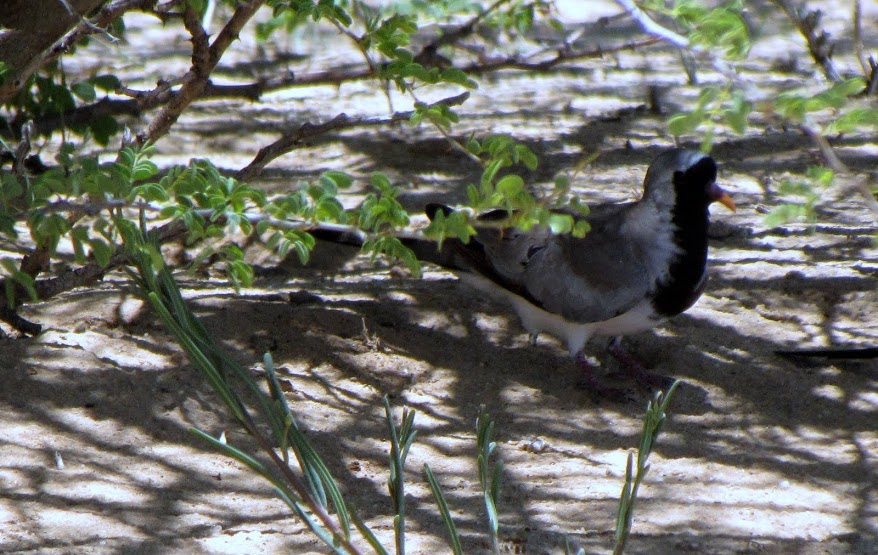
Re: Pigeons and Doves - Bird of the Month February 2014
Posted: Wed Feb 12, 2014 8:23 am
by Flutterby
The
Emerald Spotted Wood-Dove or
Greenspotted Dove (Groenvlekduifie) (Turtur chalcospilos)is a pigeon which is a widespread and often abundant resident breeding bird in eastern Africa from Ethiopia to South Africa. It also occurs in a belt from northern Botswana west to northern Namibia, and in a narrow coastal strip through Angola to Gabon.
This is a species of open drier deciduous woodland and second growth. It is absent from evergreen rainforests and semidesert areas.
The Emerald-spotted Wood Dove is a small plump pigeon, typically 20 cm in length. Its back, hindneck, wings and tail are pale grey brown, and the folded wings have green metallic patches. There are blackish bands on the lower back and tail. The forehead, crown and nape are bluish grey, fading to pinkish grey on the throat. The underparts are mauve-pink, becoming whiter on the belly. The bill of this dove is blackish with a red base. The sexes are similar, but the female may be slightly duller than the male. The immature has duller green spots and buff fringes to the feathers.
They build a flimsy stick nest in a tree or shrub, and lay two cream-coloured eggs. Both sexes incubate for 13–17 days to hatching, and feed the squabs for 13–17 days to fledging. Many young birds are taken by mongooses and shrikes. The Emerald-spotted Wood Dove is not gregarious, but flocks may form at waterholes. This species usually forages on the ground for grass and other small seeds.
The call is in three parts: two soft long coos, followed by a series of slow descending coos lasting 10 seconds, and concluding with 4 seconds of rapid coos,which decrease in volume.

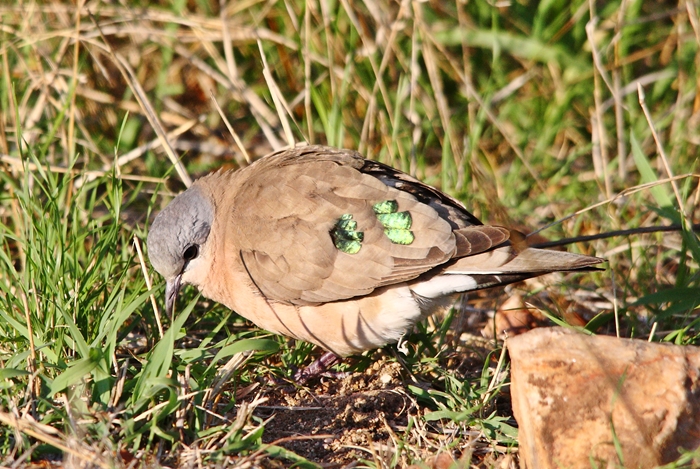
Re: Pigeons and Doves - Bird of the Month February 2014
Posted: Wed Feb 12, 2014 10:14 pm
by Super Mongoose
Re: Pigeons and Doves - Bird of the Month February 2014
Posted: Wed Feb 12, 2014 10:53 pm
by nan
Emerald-Spotted (Greenspotted) Wood-Dove
Kruger

Sirheni 22.3.2011

12.10.2009
Re: Pigeons and Doves - Bird of the Month February 2014
Posted: Thu Feb 13, 2014 9:59 am
by Flutterby
The
Cape Turtle Dove or
Ring-necked Dove (Gewone Tortelduif) (Streptopelia capicola) is a widespread and often abundant dove species in East and southern Africa. It is a mostly sedentary bird, found in a variety of open habitats. Within range, its penetrating and rhythmic, three-syllabled crooning is a familiar sound at any time of the year.
Their body feathers are darkest on the upper side, where they are coloured in dull tones of grey and brown, with shades of lavender on the nape and paler below.The lower belly is white. The semi-collar of black feathers on the lower nape is a feature shared with a number of Streptopelia species, as are the white fringes and conspicuous white tips to the otherwise slate grey tail feathers. The tail pattern is particularly noticeable during the display flight. Males and females look alike, although the males are slightly bigger. They measure 25–26.5 cm in length and weigh 92–188 g. The eyes are almost black, the bill is black and the feet are dark purple.
It occupies a diverse range of habitat types, including semi-desert scrub, Boscia and Acacia savannah, a variety of woodland types, farmlands, open plantations and alien acacia thickets. Only closed forest or plantations, or the extensive waterless dune fields and gravel plains of the Namib are unsuited to their requirements. In southern Africa they are most commonly observed in fynbos regions, miombo and mopane woodlands, besides any grassland types from moist to dry regions.
These doves are usually found alone or in pairs, although they do form larger flocks around roosts or sources of food and water, sometimes comprising hundreds of birds. They are quite noisy in these groups, not only for the various calls they make throughout the day, but also due to the loud clatter of their wings when they take flight.
They feed mainly on seeds, but also on broken fruit and berries and insects on occasion. Other recorded food items include small sedge bulbs, fleshy succulent leaves, aloe nectar and sugary aphid secretions.
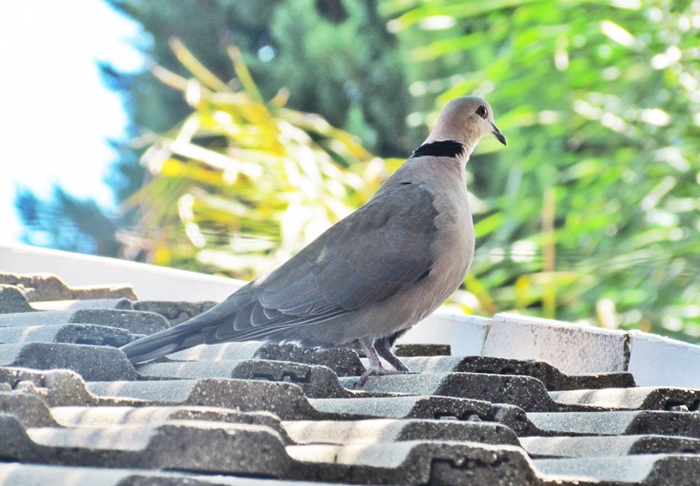
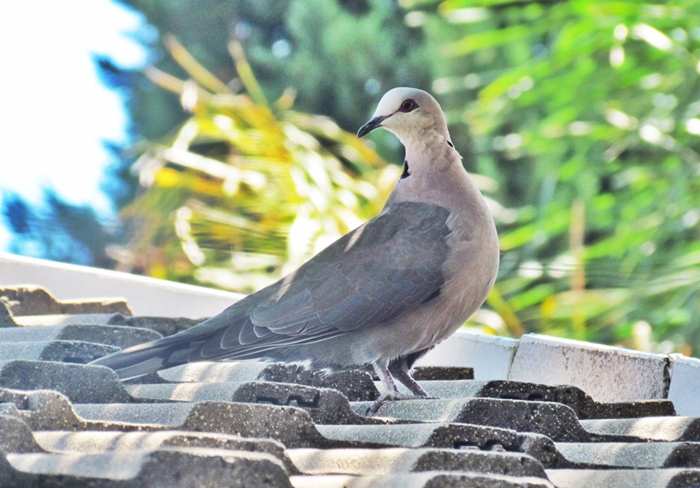
Re: Pigeons and Doves - Bird of the Month February 2014
Posted: Thu Feb 13, 2014 10:23 am
by nan
Kgalagadi 21.1.2012
to see the difference of size between a Laughing Dove and a Cape Turtle Dove




























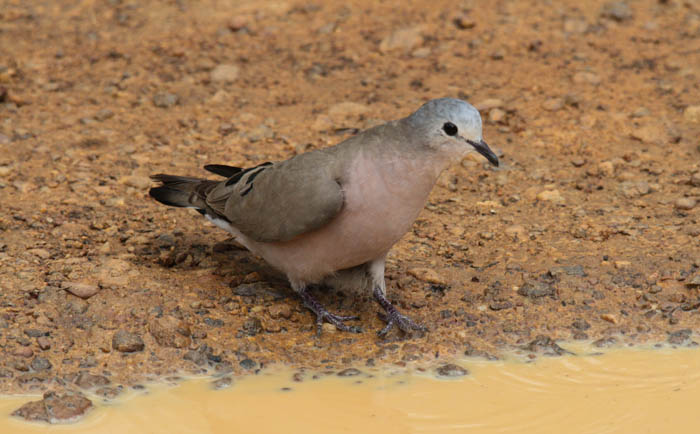
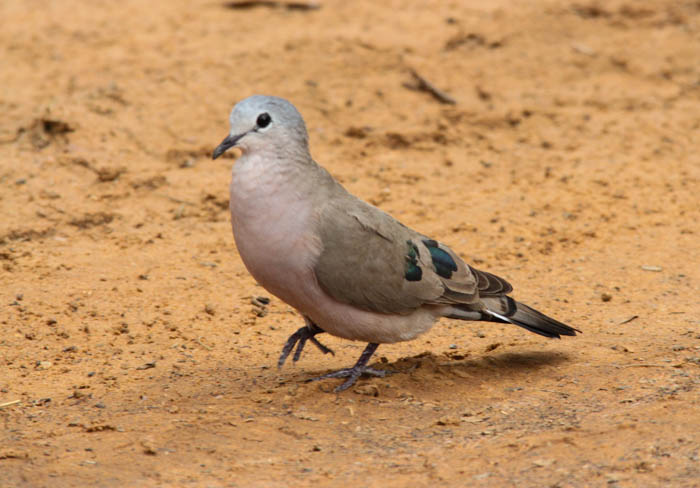

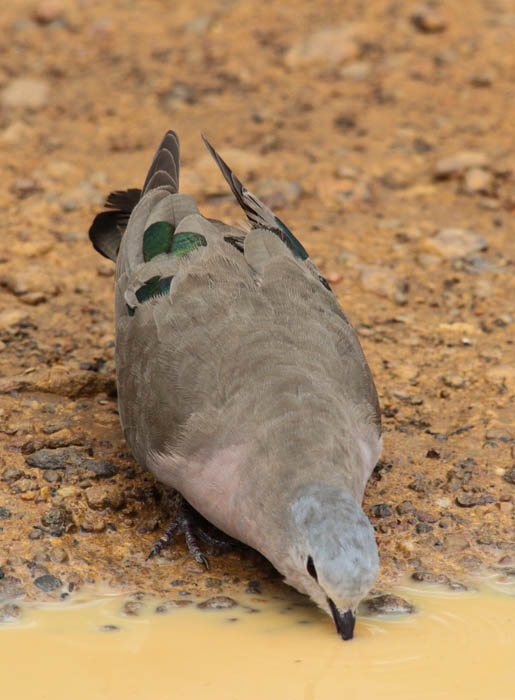
 Sirheni 22.3.2011
Sirheni 22.3.2011 12.10.2009
12.10.2009

